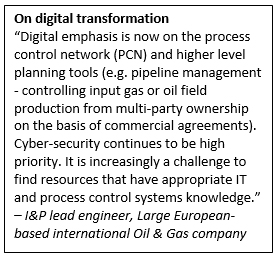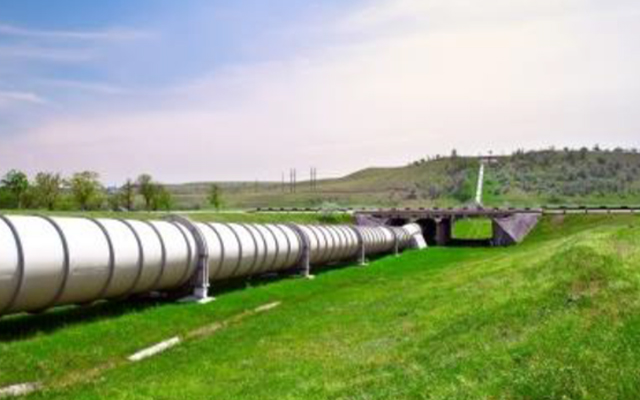Authors: Maurizio Rovaglio, Vice President, Oil & Gas Technology and Alliances, Schneider Electric, and Jack Creamer, Market Segment Manager, Pumping Equipment–Industry Business, Schneider Electric
The Oil & Gas industry spent $3.5 Billion in 2015 on big data-related projects (footnote #1), with projected annual growth of 31% by 2020 (footnote #2). What will drive this growth? Oil producers can capture more detailed data – in conjunction with OEM supplied systems – in real time at lower costs and drive profit from previously inaccessible areas. For example, by pairing real-time down-hole drilling data with production data of nearby wells, stakeholders can adapt new drilling strategies, especially in unconventional fields.
Using IIoT technologies to connect exiting automation systems in the oil field allows wide data gathering and data aggregation, so performing a number of analytics with the coming results of such analysis to be applied back to the filed. Actionable information derived from edge computing or cloud based analysis allows for closing the loop with automation systems, services providers, and OEMs on warranties and maintenance or whoever else is performing actions on the field. This leads to implementation of systems that integrate well management with functionalities, like pump control, production monitoring, alarm analysis, failure tracking by exception and work-orders management.
Moreover, since OT systems (OT representing a vast collection of physical infrastructure systems such as power and control, heating, cooling and ventilation systems) are now being equipped with either built-in connectivity intelligence, or field upgraded connectivity, much more operational performance data is being forwarded to the cloud and analyzed. This is forming a much more pervasive “sensing” layer for data gathering.
 The technologies included in this sensing layer are fundamentally the same IoT technologies used in the enterprise cloud layer, but are optimized for real time deterministic communications. The OT devices that comprise this time sensitive layer (sensors, actuators and controllers) are cloud-ready and capable of interfacing transparently with the IT business systems.
The technologies included in this sensing layer are fundamentally the same IoT technologies used in the enterprise cloud layer, but are optimized for real time deterministic communications. The OT devices that comprise this time sensitive layer (sensors, actuators and controllers) are cloud-ready and capable of interfacing transparently with the IT business systems.
In pipeline operations, as a result of open standards and centralized data management, IIoT allows seamless integration and operation across different pipeline operation systems such as simulation, forecasting and planning, measurement and asset management. IIoT increases system availability through accurate, timely data, and a resulting improved response to abnormal operations.
As part of the IIoT evolution, optical fiber is increasingly being deployed in many upstream and midstream applications. Optical fiber is used to provide high band-width telecommunications and infrastructure for Supervisory Control and Data Acquisition (SCADA), and is being used more to sense pressure, temperature and strain along buried onshore pipelines, on subsea pipelines and down hole. With Distributed Acoustic Sensing (DAS), an optical fiber is used for both sensing and telemetry, collecting a huge amount of data used to map the impact of earthquakes on pipelines.
Despite the developing industry trends, the fundamental principles of pipeline operators have not changed. Pipelines must operate 24 hours a day and 365 days a year, and, as such, safety, high availability and reliability are key requirements for pipeline management systems and the supporting infrastructure.
Oil & Gas pipeline communications and technologies are constantly evolving to address a multitude of new entry points. Such an evolution represents the trade-off of processing increased amounts of data to ensure efficient, optimized, and stream-lined pipeline operations while opening the door to higher risk of compromising operational systems security.
Vendors and equipment suppliers can help Oil & Gas companies achieve these goals through dedication to high-quality engineering and to processes that ensure consistent levels of security in products that are developed across global research facilities. Manufacturers like Schneider Electric have invested millions of dollars in the ongoing development of secure software, core product enhancements and expanded application suites.
Footnotes:
- Visiongain, “Big Data in Oil & Gas Market 2015-2025”, September, 2015
- Technavio, “Global Big Data in Oil and Gas Sector Set to Grow at a CAGR of 31% by 2020”, December, 2015
This article is part of an eight-part series looking at how the Industrial Internet of Things (IIoT) concepts are transforming the Oil & Gas industry business model. For more information, please visit: goo.gl/4ohXN7.
About the Authors
Maurizio Rovaglio is Vice President of Oil & Gas Technology and Alliances at Schneider Electric in Italy. Mr. Rovagilo holds multiple patents and has authored over 100 technical articles published in international scientific journals, and has delivered presentations at multiple international conferences. Mr. Rovaglio has over 15 years’ experience in software sales, marketing, resource planning and project execution in the O&G domain across the world.
Jack Creamer is Schneider Electric Segment Marketing Manager – Pumping Equipment, based in the United States. Mr. Creamer has more that 30 years in the Electrical Industry, and has been involved for 10 years in the Pumping Industry. He is involved in key industry organizations such as the Hydraulic Institute and Submersible Wastewater Pump Association, where he holds both Committee Chair and Board level positions. In his time in the Pump industry, he has help Schneider create numerous solutions that both enhance pumping efficiency and address issues such as maintenance and downtime.




